- Trang chủ
- Về chúng tôi
- Ngành
- Dịch vụ
- Đọc
- Liên hệ với chúng tôi
Thị trường Khối Bộ nhớ Hybrid: Phân tích Hiện tại và Dự báo (2023-2030)
Nhấn mạnh vào Loại Sản phẩm (GPU, CPU, APU, FPGA và ASIC); Ứng dụng (Đồ họa, AI và Điện toán Hiệu năng Cao, Mạng và Trung tâm Dữ liệu); Người dùng Cuối (Lưu trữ Doanh nghiệp, Viễn thông và Mạng, Nhà phát triển Trí tuệ Nhân tạo và Các loại khác); và Khu vực/Quốc gia
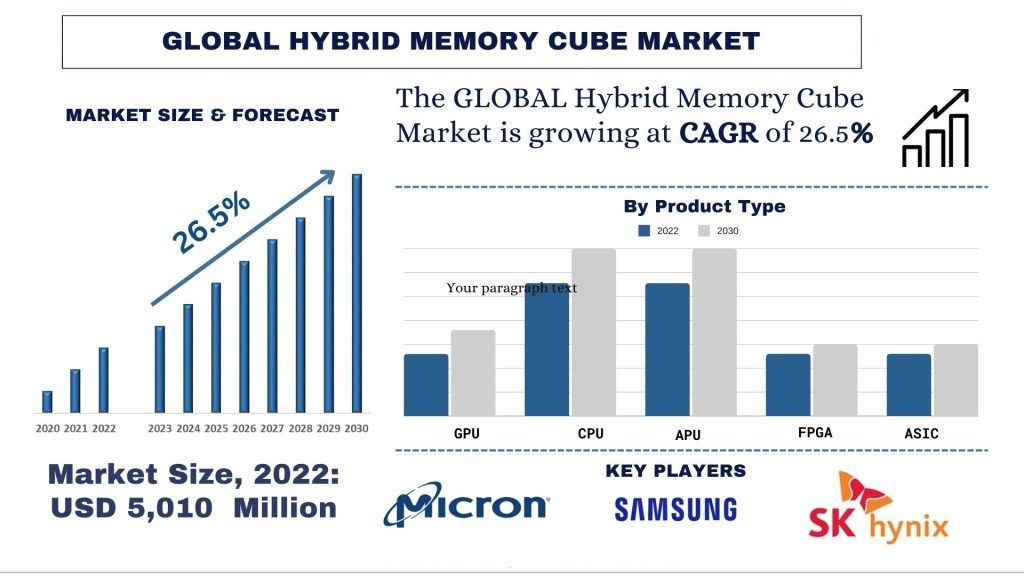
Kích thước & dự báo của thị trường Hybrid Memory Cube
Thị trường Hybrid Memory Cube được định giá 5.010 triệu USD và dự kiến sẽ tăng trưởng với tốc độ CAGR mạnh mẽ khoảng 26,50% trong giai đoạn dự báo (2023-2030) do sự gia tăng nhanh chóng của Trí tuệ nhân tạo.
Phân tích thị trường Hybrid Memory Cube
Sự tăng trưởng của Thị trường Hybrid Memory Cube có thể là do sự gia tăng nhanh chóng của trí tuệ nhân tạo. Bản thân công nghệ này đang trải qua tốc độ phát triển và áp dụng chưa từng có. Sự thay đổi này hướng tới AI đã làm tăng nhu cầu về GPU hiệu suất cao, tạo ra một môi trường nhu cầu thuận lợi cho HMC. Ví dụ: vào tháng 2 năm 2024, Nvidia, nhà sản xuất GPU lớn nhất thế giới, đã đưa ra dự báo về mức tăng gấp ba lần doanh thu hàng quý nhờ nhu cầu tăng cao đối với chip trung tâm dữ liệu và GPU trong bối cảnh bùng nổ AI mà thế giới đang chứng kiến. Hơn nữa, các tổ chức đang chuyển hoạt động của họ lên đám mây. Xu hướng hướng tới đám mây này đã làm tăng nhu cầu về các trung tâm dữ liệu, do đó làm tăng nhu cầu về HMC, một công nghệ lưu trữ hiệu quả hơn và ít tiêu thụ điện năng hơn. Ngoài ra, sự phổ biến của máy tính hiệu suất cao cũng đang tăng lên do nhu cầu ngày càng tăng về các tính toán công suất cao để đào tạo các mô hình AI, từ đó dẫn đến sự gia tăng nhu cầu về HMC trên thị trường.
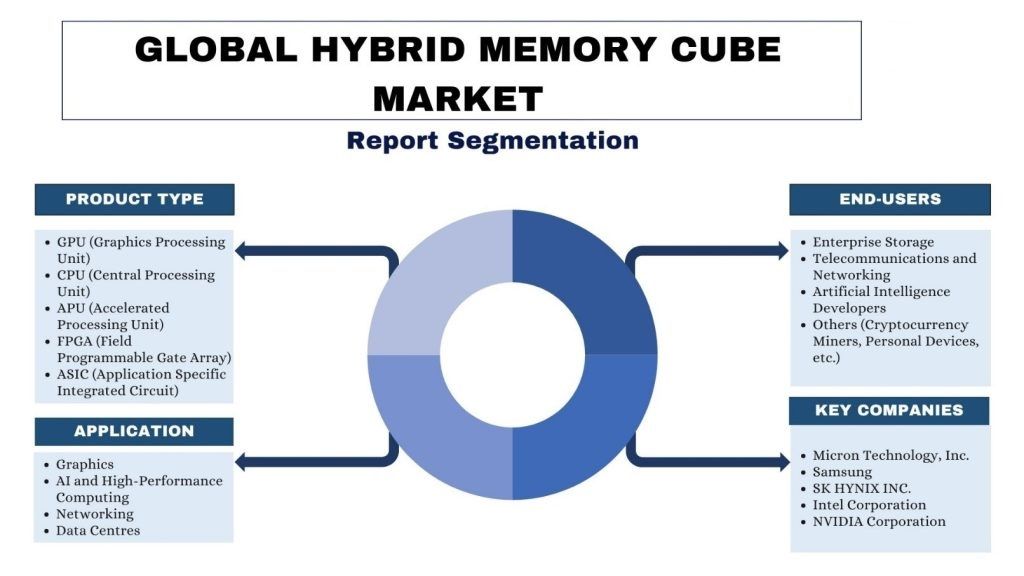
Xu hướng thị trường Hybrid Memory Cube
Phần này thảo luận về các xu hướng thị trường chính đang ảnh hưởng đến các phân khúc khác nhau của Thị trường Hybrid Memory Cube như được xác định bởi nhóm các chuyên gia nghiên cứu của chúng tôi.
Kịch bản nhu cầu cao đối với GPU đang chuyển đổi ngành
Phân khúc GPU đang tạo ra nhu cầu tối đa cho HMC trên thị trường. Sự gia tăng ngày càng nhiều của AI tạo sinh chủ yếu thúc đẩy sự mở rộng này. Hơn nữa, sự tiến bộ nhanh chóng trong việc phát triển cơ sở hạ tầng đám mây, bởi các tập đoàn lớn như Amazon và Meta, trong bối cảnh nhu cầu to lớn về sức mạnh tính toán để hỗ trợ các dự án AI, đang tạo ra một môi trường tăng trưởng thuận lợi về nhu cầu đối với GPU, do đó mang lại lợi ích cho nhu cầu ngày càng tăng đối với HMC. Ví dụ: vào tháng 1 năm 2024, Giám đốc điều hành của Meta đã công bố khoản đầu tư một tỷ đô la vào việc mua 350.000 đơn vị chip đồ họa H100 của Nvidia để phát triển cơ sở hạ tầng điện toán của mình vào cuối năm 2024.
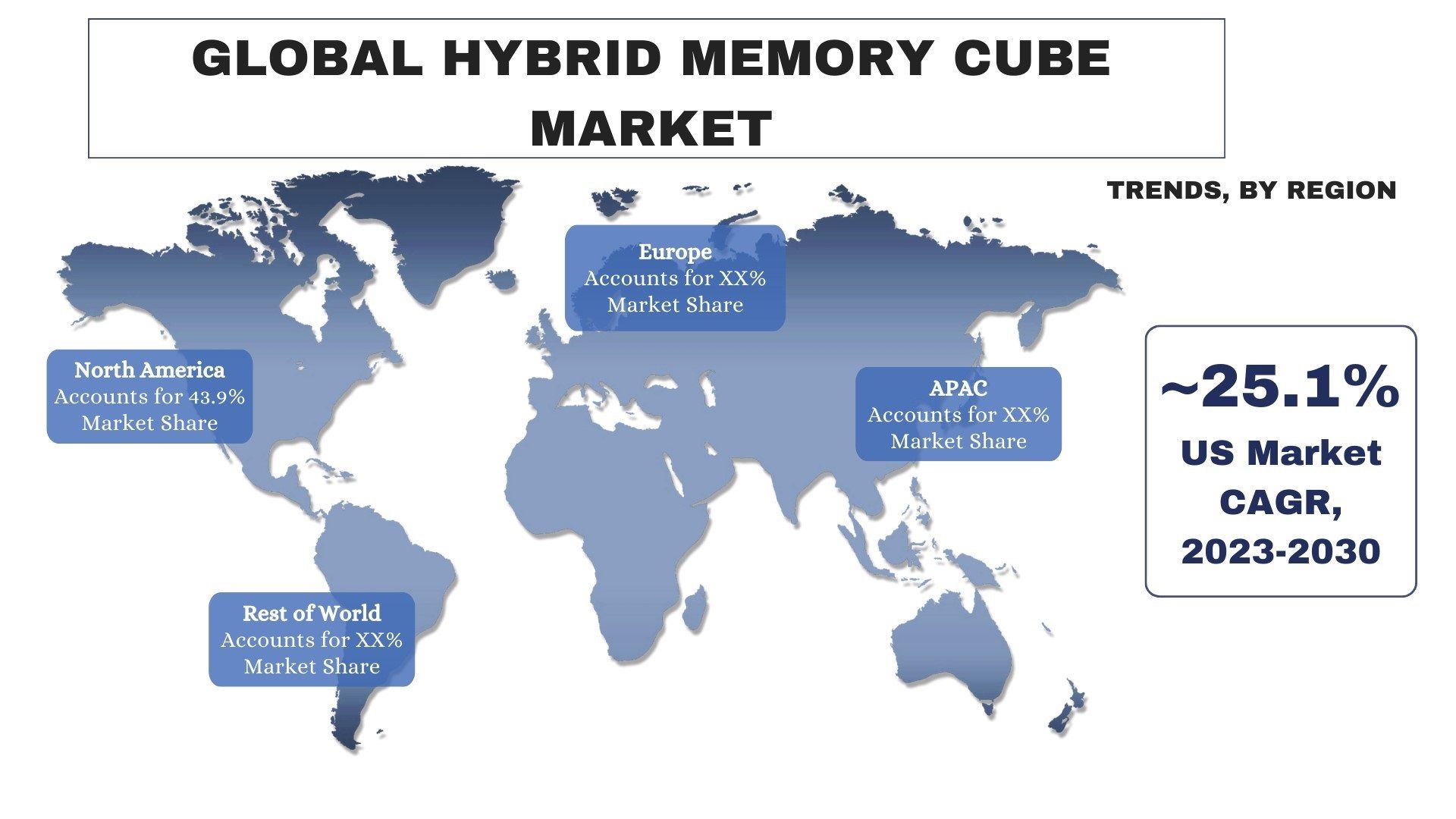
Bắc Mỹ nắm giữ thị phần nổi bật của Hybrid Memory Cube về mặt thị phần
Trong Bắc Mỹ, Hoa Kỳ nắm giữ phần lớn thị phần. Yếu tố chính thúc đẩy sự tăng trưởng của thị trường ở quốc gia này là môi trường pháp lý thuận lợi giúp ngành công nghiệp phát triển với tốc độ chưa từng có.
Thị trường Hybrid Memory Cube ở Bắc Mỹ sẵn sàng tăng trưởng nhanh chóng trong những năm tới. Sự gia tăng nhu cầu này chủ yếu được thúc đẩy bởi sự tăng trưởng nhanh chóng của các ứng dụng thâm dụng dữ liệu, đặc biệt là trong trí tuệ nhân tạo và siêu máy tính, đòi hỏi khả năng xử lý dữ liệu tốc độ cao, điều này đòi hỏi bộ nhớ băng thông cao. Hơn nữa, việc tăng cường tài trợ cho các công ty khởi nghiệp AI đã đẩy nhanh tốc độ phát triển và ứng dụng các công nghệ AI trong khu vực. Hơn nữa, các chính sách thuận lợi của chính phủ trong khu vực liên quan đến phát triển AI cũng đã khuyến khích các ngành công nghiệp áp dụng công nghệ AI và đóng góp đáng kể vào sự tăng trưởng. Sự trỗi dậy nhanh chóng của AI tạo sinh đã thúc đẩy nhu cầu về các công nghệ HBM tốc độ cao trên thị trường trung tâm dữ liệu. Khối lượng công việc AI đang thúc đẩy nhu cầu về băng thông cao hơn để tăng tốc độ truyền dữ liệu giữa các thiết bị và đơn vị xử lý. Các nhà cung cấp dịch vụ đám mây quy mô lớn và các nhà sản xuất thiết bị gốc (OEM) đang tăng dung lượng máy chủ của họ để hỗ trợ đào tạo và suy luận mô hình, đòi hỏi nhiều bộ tăng tốc AI hơn. Điều này đến lượt thúc đẩy sự tăng trưởng mạnh mẽ của HBM liên quan đến các bộ tăng tốc này.
Tổng quan về ngành Hybrid Memory Cube
Thị trường Hybrid Memory Cube mang tính cạnh tranh và phân mảnh, với sự hiện diện của một số người chơi trên thị trường toàn cầu và quốc tế. Các công ty chủ chốt đang áp dụng các chiến lược tăng trưởng khác nhau để tăng cường sự hiện diện trên thị trường của họ, chẳng hạn như quan hệ đối tác, thỏa thuận, hợp tác, ra mắt sản phẩm mới, mở rộng địa lý và sáp nhập và mua lại. Một số công ty lớn hoạt động trên thị trường là Micron Technology, Inc.; Samsung; SK HYNIX INC.; Intel Corporation; NVIDIA Corporation; Global Unichip Corp; Cambricon; Huawei Technologies Co.,; IBM; và Advanced Micro Devices, Inc.
Tin tức thị trường Hybrid Memory Cube
- Ví dụ: Việc NVIDIA gần đây phát hành GH200 Grace Hopper, được trang bị bộ nhớ HBM3e đầu tiên trên thế giới, tự hào có dung lượng đáng kinh ngạc 141GB, phản ánh nhu cầu ngày càng tăng đối với các giải pháp bộ nhớ dung lượng cao.
- Ví dụ: “Kế hoạch phát triển trí tuệ nhân tạo thế hệ mới” của Trung Quốc đặt mục tiêu phát triển ngành công nghiệp AI của nước này lên hơn 150 tỷ USD vào năm 2030.
Phạm vi báo cáo thị trường Hybrid Memory Cube
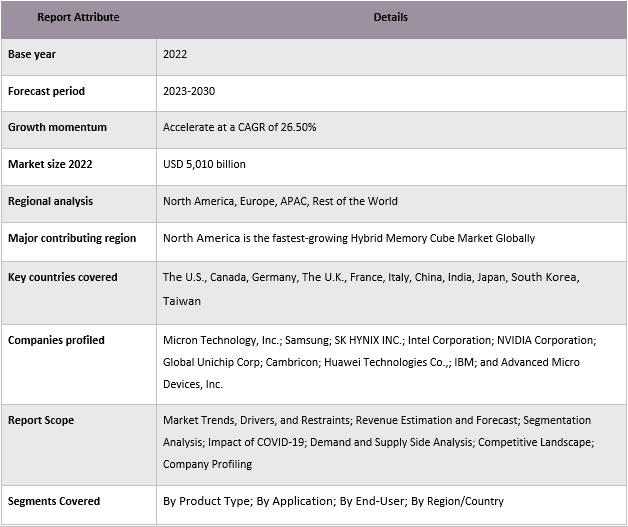
Lý do nên mua báo cáo này:
- Nghiên cứu bao gồm phân tích quy mô thị trường và dự báo được xác thực bởi các chuyên gia ngành công nghiệp quan trọng đã được xác thực.
- Báo cáo trình bày một đánh giá nhanh về hiệu suất tổng thể của ngành trong nháy mắt.
- Báo cáo bao gồm phân tích chuyên sâu về các đồng nghiệp nổi bật trong ngành, tập trung chủ yếu vào tình hình tài chính kinh doanh chính, danh mục sản phẩm, chiến lược mở rộng và các phát triển gần đây.
- Xem xét chi tiết các động lực, hạn chế, xu hướng chính và cơ hội hiện hành trong ngành.
- Nghiên cứu bao quát toàn diện thị trường trên các phân khúc khác nhau.
- Phân tích chuyên sâu ở cấp khu vực của ngành.
Tùy chọn tùy chỉnh:
Thị trường Hybrid Memory Cube toàn cầu có thể được tùy chỉnh thêm theo yêu cầu hoặc bất kỳ phân khúc thị trường nào khác. Bên cạnh đó, UMI hiểu rằng bạn có thể có nhu cầu kinh doanh riêng, vì vậy vui lòng liên hệ với chúng tôi để nhận được một báo cáo hoàn toàn phù hợp với yêu cầu của bạn.

Bạn cũng có thể mua các phần của báo cáo này. Bạn có muốn xem danh sách giá
theo từng phần không?
Mục lục
Phương Pháp Nghiên Cứu Phân Tích Thị Trường Hybrid Memory Cube (2023-2030)
Phân tích thị trường lịch sử, ước tính thị trường hiện tại và dự báo thị trường tương lai của thị trường Hybrid Memory Cube toàn cầu là ba bước chính được thực hiện để tạo và phân tích việc ứng dụng Hybrid Memory Cube ở các khu vực lớn trên toàn cầu. Nghiên cứu thứ cấp toàn diện đã được thực hiện để thu thập các số liệu thị trường lịch sử và ước tính quy mô thị trường hiện tại. Thứ hai, để xác thực những hiểu biết sâu sắc này, nhiều phát hiện và giả định đã được xem xét. Hơn nữa, các cuộc phỏng vấn sơ cấp toàn diện cũng đã được thực hiện với các chuyên gia trong ngành trên toàn bộ chuỗi giá trị của thị trường Hybrid Memory Cube toàn cầu. Sau khi giả định và xác thực các số liệu thị trường thông qua các cuộc phỏng vấn sơ cấp, chúng tôi đã sử dụng phương pháp tiếp cận từ trên xuống/từ dưới lên để dự báo quy mô thị trường hoàn chỉnh. Sau đó, các phương pháp phân tích chi tiết thị trường và tam giác dữ liệu đã được áp dụng để ước tính và phân tích quy mô thị trường của các phân khúc và phân nhóm của ngành liên quan đến. Phương pháp luận chi tiết được giải thích dưới đây:
Phân Tích Quy Mô Thị Trường Lịch Sử
Bước 1: Nghiên Cứu Chuyên Sâu Các Nguồn Thứ Cấp:
Một nghiên cứu thứ cấp chi tiết đã được thực hiện để thu thập quy mô thị trường lịch sử của thị trường Hybrid Memory Cube thông qua các nguồn nội bộ của công ty, chẳng hạn như báo cáo thường niên & báo cáo tài chính, thuyết trình hiệu suất, thông cáo báo chí, v.v. và các nguồn bên ngoài bao gồm tạp chí, tin tức & bài báo, ấn phẩm của chính phủ, ấn phẩm của đối thủ cạnh tranh, báo cáo ngành, cơ sở dữ liệu của bên thứ ba và các ấn phẩm đáng tin cậy khác.
Bước 2: Phân Khúc Thị Trường:
Sau khi thu thập được quy mô thị trường lịch sử của thị trường Hybrid Memory Cube, chúng tôi đã tiến hành phân tích thứ cấp chi tiết để thu thập thông tin chi tiết về thị trường lịch sử và chia sẻ cho các phân khúc & phân nhóm khác nhau cho các khu vực lớn. Các phân khúc chính được bao gồm trong báo cáo là loại sản phẩm, ứng dụng và người dùng cuối. Phân tích cấp quốc gia sâu hơn đã được thực hiện để đánh giá việc áp dụng tổng thể các mô hình thử nghiệm ở khu vực đó.
Bước 3: Phân Tích Yếu Tố:
Sau khi có được quy mô thị trường lịch sử của các phân khúc và phân nhóm khác nhau, chúng tôi đã tiến hành phân tích yếu tố chi tiết để ước tính quy mô thị trường hiện tại của thị trường Hybrid Memory Cube. Hơn nữa, chúng tôi đã tiến hành phân tích yếu tố bằng cách sử dụng các biến phụ thuộc và độc lập như loại sản phẩm, ứng dụng và người dùng cuối của thị trường Hybrid Memory Cube. Một phân tích kỹ lưỡng đã được thực hiện về các kịch bản cung và cầu, có tính đến các quan hệ đối tác hàng đầu, sáp nhập và mua lại, mở rộng kinh doanh và ra mắt sản phẩm trong lĩnh vực thị trường Hybrid Memory Cube trên toàn cầu.
Ước Tính & Dự Báo Quy Mô Thị Trường Hiện Tại
Định cỡ thị trường hiện tại: Dựa trên những hiểu biết sâu sắc có thể hành động từ 3 bước trên, chúng tôi đã đi đến quy mô thị trường hiện tại, những người chơi chính trên thị trường Hybrid Memory Cube toàn cầu và thị phần của các phân khúc. Tất cả các tỷ lệ phần trăm cần thiết được chia và phân tích chi tiết thị trường đã được xác định bằng phương pháp thứ cấp được đề cập ở trên và đã được xác minh thông qua các cuộc phỏng vấn sơ cấp.
Ước tính & Dự báo: Đối với ước tính và dự báo thị trường, trọng số đã được gán cho các yếu tố khác nhau bao gồm các động lực & xu hướng, hạn chế và cơ hội dành cho các bên liên quan. Sau khi phân tích các yếu tố này, các kỹ thuật dự báo phù hợp, tức là phương pháp tiếp cận từ trên xuống/từ dưới lên đã được áp dụng để đưa ra dự báo thị trường cho năm 2030 cho các phân khúc và phân nhóm khác nhau trên các thị trường lớn trên toàn cầu. Phương pháp nghiên cứu được áp dụng để ước tính quy mô thị trường bao gồm:
- Quy mô thị trường của ngành, về doanh thu (USD) và tỷ lệ chấp nhận của thị trường Hybrid Memory Cube trên các thị trường lớn trong nước
- Tất cả các tỷ lệ phần trăm, phân chia và phân tích chi tiết của các phân khúc và phân nhóm thị trường
- Những người chơi chính trên thị trường Hybrid Memory Cube toàn cầu về các sản phẩm được cung cấp. Ngoài ra, các chiến lược tăng trưởng được những người chơi này áp dụng để cạnh tranh trong thị trường đang phát triển nhanh chóng.
Xác Thực Quy Mô và Thị Phần Thị Trường
Nghiên cứu sơ cấp: Các cuộc phỏng vấn chuyên sâu đã được thực hiện với các nhà lãnh đạo quan điểm chủ chốt (KOL) bao gồm các giám đốc điều hành cấp cao nhất (CXO/VP, Trưởng phòng kinh doanh, Trưởng phòng marketing, Trưởng phòng vận hành, Trưởng phòng khu vực, Trưởng phòng quốc gia, v.v.) trên khắp các khu vực lớn. Các phát hiện nghiên cứu sơ cấp sau đó đã được tóm tắt và phân tích thống kê đã được thực hiện để chứng minh giả thuyết đã nêu. Thông tin đầu vào từ nghiên cứu sơ cấp đã được hợp nhất với các phát hiện thứ cấp, do đó biến thông tin thành những hiểu biết sâu sắc có thể hành động.
Phân Bổ Người Tham Gia Nghiên Cứu Sơ Cấp ở Các Khu Vực Khác Nhau
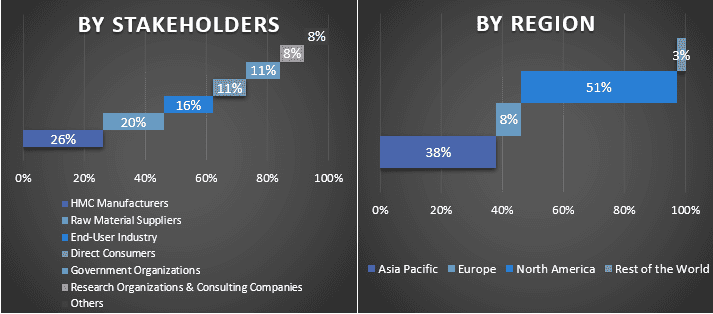
Kỹ thuật thị trường
Kỹ thuật tam giác dữ liệu đã được sử dụng để hoàn thành ước tính thị trường tổng thể và đưa ra các con số thống kê chính xác cho từng phân khúc và phân nhóm của thị trường Hybrid Memory Cube toàn cầu. dữ liệu đã được chia thành một số phân khúc & phân nhóm sau khi nghiên cứu các thông số và xu hướng khác nhau trong các lĩnh vực loại sản phẩm, ứng dụng và người dùng cuối trên thị trường Hybrid Memory Cube toàn cầu.
Mục tiêu chính của Nghiên cứu Thị trường Hybrid Memory Cube Toàn cầu
Các xu hướng thị trường hiện tại & tương lai của thị trường Hybrid Memory Cube toàn cầu đã được xác định chính xác trong nghiên cứu. Các nhà đầu tư có thể đạt được những hiểu biết sâu sắc về chiến lược để dựa vào quyết định của họ cho các khoản đầu tư dựa trên phân tích định tính và định lượng được thực hiện trong nghiên cứu. Các xu hướng thị trường hiện tại và tương lai đã xác định sức hấp dẫn tổng thể của thị trường ở cấp khu vực, cung cấp một nền tảng cho người tham gia công nghiệp khai thác thị trường chưa được khai thác để hưởng lợi từ lợi thế của người đi đầu. Các mục tiêu định lượng khác của nghiên cứu bao gồm:
- Phân tích quy mô thị trường hiện tại và dự báo của thị trường Hybrid Memory Cube về giá trị (USD). Ngoài ra, hãy phân tích quy mô thị trường hiện tại và dự báo của các phân khúc và phân nhóm khác nhau.
- Các phân khúc trong nghiên cứu bao gồm các lĩnh vực loại sản phẩm, ứng dụng và người dùng cuối.
- Xác định và phân tích khuôn khổ pháp lý cho Hybrid Memory Cube
- Phân tích chuỗi giá trị liên quan đến sự hiện diện của các trung gian khác nhau, cùng với việc phân tích hành vi của khách hàng và đối thủ cạnh tranh của ngành
- Phân tích quy mô thị trường hiện tại và dự báo của thị trường Hybrid Memory Cube cho khu vực chính
- Các quốc gia lớn của các khu vực được nghiên cứu trong báo cáo bao gồm Châu Á Thái Bình Dương, Châu Âu, Bắc Mỹ và Phần còn lại của Thế giới
- Hồ sơ công ty của thị trường Hybrid Memory Cube và các chiến lược tăng trưởng được những người chơi trên thị trường áp dụng để duy trì trong thị trường đang phát triển nhanh chóng.
- Phân tích sâu về cấp khu vực của ngành
Câu hỏi thường gặp Câu hỏi thường gặp
Câu hỏi 1: Quy mô thị trường hiện tại và tiềm năng tăng trưởng của thị trường Hybrid Memory Cube toàn cầu là bao nhiêu?
Q2: Đâu là những yếu tố thúc đẩy sự tăng trưởng của Thị trường Khối Bộ nhớ Hybrid toàn cầu?
Q3: Phân khúc nào có tốc độ tăng trưởng nhanh nhất của thị trường Hybrid Memory Cube toàn cầu theo loại sản phẩm?
Q4: Các công nghệ và xu hướng mới nổi trong thị trường Hybrid Memory Cube toàn cầu là gì?
Q5: Khu vực nào sẽ là thị trường Hybrid Memory Cube toàn cầu phát triển nhanh nhất?
Q6: Ai là những người chơi chủ chốt trên thị trường Hybrid Memory Cube toàn cầu?
Liên quan Báo cáo
Khách hàng đã mua mặt hàng này cũng đã mua










